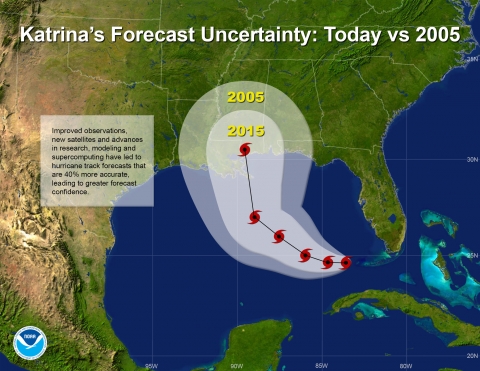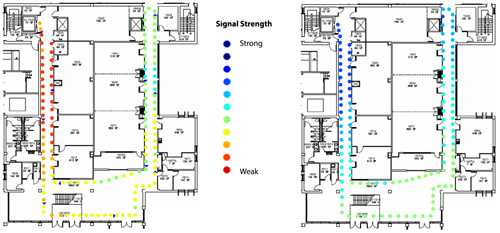NTIA Blog
Satellite Technology and Spectrum Key to Better Weather Forecasting
Ten years ago, one of the deadliest hurricanes in history struck the Gulf Coast, decimating coastal cities and communities from Gulfport, Miss., to New Orleans. At the time, the National Weather Service (NWS), an agency of the U.S. Commerce Department’s National Oceanic and Atmospheric Administration (NOAA), accurately forecasted more than two days ahead of time that the central Gulf Coast would be directly impacted by Hurricane Katrina. While this forecast undoubtedly helped limit the loss of life and property, communities across the Gulf Coast still suffered billions of dollars in damage and hundreds died in the storm’s aftermath, according to NOAA’s National Climatic Data Center.

A comparison of the cone of uncertainty given 2005 forecasting capability and 2015 forecasting capability.
An Update on the IANA Transition
The Internet’s global multistakeholder community has made tremendous progress in its work to develop a proposal to transition the historic stewardship role NTIA has played related to Internet’s domain name system (DNS).
When we announced our intent in March 2014 to complete the privatization of the DNS, we noted that the base period of our contract with ICANN to perform technical functions related to the DNS, known as the IANA functions, expired on September 30, 2015. However, it has become increasingly apparent over the last few months that the community needs time to complete its work, have the plan reviewed by the U.S. Government and then implement it if it is approved.
Accordingly, in May we asked the groups developing the transition documents how long it would take to finish and implement their proposals. After factoring in time for public comment, U.S. Government evaluation and implementation of the proposals, the community estimated it could take until at least September 2016 to complete this process. In response to their feedback, we informed Congress on Friday that we plan to extend our IANA contract with ICANN for one year to September 30, 2016. Beyond 2016, we have options to extend the contract for up to three additional years if needed.
Sustaining ITS Technical Expertise through the Senior Technical Fellow Program
The Institute for Telecommunication Sciences (ITS), NTIA’s research and engineering laboratory in Boulder, Colo., provides critical support to NTIA and other agencies by performing basic and applied research in radio science—which enables every wireless communications device, from smart phones, to military radars, to space satellites to operate.
As part of our efforts to expand the reach of this important work, I am pleased to announce the launch of a new Senior Technical Fellow program to enhance the Institute’s focus on scientific excellence and engineering innovation. It also provides a more formalized way to sustain and share ITS technical expertise with the Institute’s younger generation of engineers. The program recognizes the outstanding technical achievements of senior ITS researchers and allows them to devote more time to training and mentoring junior and mid-level scientists and engineers.
Frank Sanders, who has served as Chief of the Telecommunications Theory Division, has been named as the first senior technical fellow under the new ITS program. He is a renowned subject matter expert on radar system design, radar spectrum emissions, and radar receiver sensitivity to interference, and on the analysis and resolution of electromagnetic compatibility problems.
Let Your Voice be Heard on IANA Transition
Nearly 17 months ago, NTIA kicked off activities to complete the privatization of the Internet Domain Name System (DNS) as promised in 1998 by transitioning our stewardship role over certain technical functions related to the DNS.
We have reached an important milestone in that process as the two working groups tasked with developing proposals related to the transition have released them for final comment.
These technical functions, known as the IANA functions, play an important but limited role in how the DNS and Internet operate. The DNS allows users to identify websites, mail servers, and other Internet destinations using easy-to-understand names (e.g., www.ntia.doc.gov) rather than the numeric network addresses (e.g., 170.110.225.163) necessary to retrieve information on the Internet.
The IANA transition will advance our commitment to ensuring that the Internet remains an engine for global economic growth, innovation and free speech.
Since March 2014, the Internet community – made up of technical experts, businesses and civil society – has spent hundreds of hours devising a transition proposal that aims to meet the principles we outlined, including preserving the openness, security and resiliency of the Internet.
Spotlight on NTIA: Stacy Cheney, Senior Attorney-Advisor, Office of the Chief Counsel
This post is part of our “Spotlight on NTIA” blog series, which is highlighting the work that NTIA employees are doing to advance NTIA’s mission of promoting broadband adoption, finding spectrum to meet the growing demand for wireless technologies, and ensuring the Internet remains an engine for innovation and economic growth.
 Stacy Cheney, a senior attorney advisor in the Office of Chief Counsel, started out his career in a private law firm but realized early on that public service and the issues that NTIA deals with in particular were his true calling.
Stacy Cheney, a senior attorney advisor in the Office of Chief Counsel, started out his career in a private law firm but realized early on that public service and the issues that NTIA deals with in particular were his true calling.
Many here at NTIA might know Cheney as the attorney who sends you those emails asking you to comply with a Freedom of Information Act (FOIA) request. But he plays a much broader role at NTIA, including contributing to cutting-edge and impactful issues. While some of his job deals with general administrative law like Federal Register notices and FOIA requests, he has worked on many other exciting projects including NTIA’s work related to the Internet’s domain name system and digital copyright law for which he earned gold and bronze medal awards from the Commerce Department.
Innovative Research Helps Emergency Responders Better Communicate While Indoors

These diagrams illustrate the results of measurements of signal strength along one walk route. On the left are the results of when signals are being transmitted only by the cell tower located two km from the test site. On the right are the results of when transmissions are supplemented by in-building systems. The benefits of supplemental cells are easily seen by comparing the colors between the left and right diagrams with red showing poor coverage and blue showing good coverage.
Nearly everyone is familiar with the need to step outside a building to complete a wireless call. Modern building materials, such as aluminum, steel and even specially-coated window glass, significantly reduce or even block wireless signals
While it might be inconvenient for your average mobile device user, it could become a matter of life or death for an emergency first responder. Police officers and firefighters cannot stop what they are doing to leave a building in order to communicate during a time of crisis.
Understanding Federal Spectrum Use
In recent days, there has been a great deal of discussion about how much spectrum federal agencies use and whether that spectrum is being used efficiently. This is an important conversation to have and one that goes to the heart of NTIA’s statutory mission of fostering full and efficient use of the nation’s spectrum resources in a manner that most benefits the public interest. If we are to make progress toward a more efficient use of spectrum, it is also essential that this discussion include a full and balanced assessment of the challenges and trade-offs that must be addressed.
NTIA’s BroadbandUSA Work Complementing ConnectHome Initiative
On Wednesday, President Obama travelled to Durant, Oklahoma, where he announced ConnectHome — a plan to bring high-speed broadband Internet to low-income housing in 27 cities and one Native American tribal community. ConnectHome is just one component of a broader Administration initiative to expand broadband and close the digital divide, and NTIA is playing a critical role in that effort.
Working to expand broadband access and adoption is a core mission of NTIA. And for the past six years through our broadband grant program, we’ve been working with communities across the country to build high-speed networks in our most rural villages, set up computer labs in inner-city housing projects, teach critical digital literacy skills to people who may never have turned on a computer before, and so much more.
In Oklahoma where President Obama made his announcement, NTIA’s Broadband Technology Opportunity Program (BTOP) funded two infrastructure projects, built by Pine Telephone and the State of Oklahoma, which are playing an integral role in providing broadband to the Choctaw Nation. The projects are partners in the ConnectHome initiative to serve Choctaw public housing residences.
Improving Privacy, Transparency, and Accountability for Unmanned Aircraft Systems
Unmanned aircraft systems (UAS) have the potential to provide a wide range of innovative and beneficial services to businesses and consumers in the United States. From enhancing news gathering, improving agribusiness, providing new delivery models, to providing Internet in remote areas, the possibilities for UAS are staggering. Consumer trust and responsible operation are keys to fully tapping the transformative potential of unmanned aircraft.
Earlier this year, President Obama called on NTIA to launch a multistakeholder process to develop best practices that enhance privacy and promote transparent and accountable operation of UAS by commercial and private users. The end goal is best practices that mitigate consumer concerns while promoting growth and innovation in this exciting sector.
In April, we received more than 50 comments regarding the most pressing UAS issues and potential solutions. This input will be the basis of the group’s initial discussions.
Enhancing the Digital Economy Through Collaboration on Vulnerability Research Disclosure
Promoting and preserving the digital ecosystem is a core mission of the Department of Commerce, and the security and resiliency of that ecosystem is vital. For the digital economy to thrive, users must trust that their personal data and the systems and websites they use every day are as secure as possible.
To help support this goal, the Department of Commerce announced in March an initiative to address key cybersecurity issues facing the digital economy that could be best addressed by a consensus-based multistakeholder process. Based on input from a broad range of stakeholders, we are today announcing that the first cybersecurity multistakeholder process will launch in September and will focus on vulnerability research disclosure. The goal of this process will be to bring together security researchers, software vendors, and those interested in a more secure digital ecosystem to create common principles and best practices around the disclosure of and response to new security vulnerability information.
